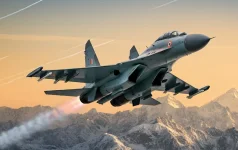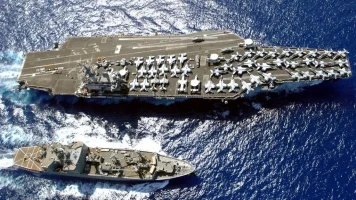- Views: 4K
- Replies: 17
India is poised to significantly enhance its strategic defence capabilities with the upcoming induction of its third nuclear-powered ballistic missile submarine (SSBN), INS Aridhaman.
The 7,000-tonne vessel is in the final phase of extensive sea trials and is anticipated to be formally commissioned into the Indian Navy by the end of 2025.
The successful completion of these trials will mark a major step forward in strengthening India’s nuclear triad and ensuring a robust, sea-based nuclear deterrent.
Developed under the highly classified Advanced Technology Vessel (ATV) project at the Ship Building Centre in Visakhapatnam, INS Aridhaman is a more advanced and formidable vessel than its predecessors.
While INS Arihant and INS Arighaat—commissioned in 2016 and 2024 respectively—cemented India's position as one of the few nations capable of building its own SSBNs, Aridhaman is considered a next-generation platform.
Scientific and defence sources indicate that it incorporates major technological upgrades, earning it the designation of the first submarine in the new S4 class.
INS Aridhaman boasts superior specifications, including a larger size and a heavier displacement of approximately 7,000 tonnes, an increase of 1,000 tonnes over the first two submarines.
It is powered by a more potent 83 MW Pressurised Light-Water Reactor designed by the Bhabha Atomic Research Centre (BARC). This upgraded reactor not only provides greater power but also features a significantly lower acoustic signature, making the submarine exceptionally difficult for enemy forces to detect.
It can achieve an underwater speed of up to 24 knots (approximately 44 km/h), with its operational range limited only by the crew's food and supplies.
The most crucial enhancement in INS Aridhaman is its expanded missile capacity. The submarine is equipped with eight vertical launch tubes, doubling the four found on INS Arihant and INS Arighaat.
This allows it to carry a more potent arsenal, such as eight K-4 missiles with a range of 3,500 km or a larger loadout of 24 K-15 Sagarika missiles (750 km range).
This increased firepower enables the submarine to target distant strategic locations from the relative safety of Indian territorial waters, solidifying the nation's second-strike capability, which is a fundamental element of its no-first-use nuclear policy.
Reflecting the success of the 'Make in India' initiative in the defence sector, INS Aridhaman features approximately 70% indigenous content. Its construction involved key contributions from Indian industrial giants like Larsen & Toubro and Tata Power.
The vessel is also fitted with state-of-the-art domestic sonar, navigation, and fire-control systems, which have been refined based on operational experience from the first two Arihant-class submarines.
The commissioning of this submarine comes at a critical time for regional security in the Indian Ocean Region (IOR).
The induction is seen as a necessary step to maintain a strategic balance in light of China’s rapidly expanding naval fleet, which includes multiple advanced SSBNs and a submarine force projected to reach 80 vessels by 2035.
Furthermore, Pakistan is also enhancing its underwater capabilities with the acquisition of eight modern Yuan-class submarines from China. INS Aridhaman, along with the under-construction naval base INS Varsha, is central to India's strategy to counter these growing maritime challenges.
As the most survivable component of India's nuclear triad—which also includes land-based missiles and air-launched weapons—a nuclear submarine guarantees the ability to retaliate even if other systems are compromised in a first strike.
By ensuring a credible and secure second-strike option, INS Aridhaman will play a vital role in maintaining strategic stability and protecting India's national interests in an increasingly contested maritime environment.


